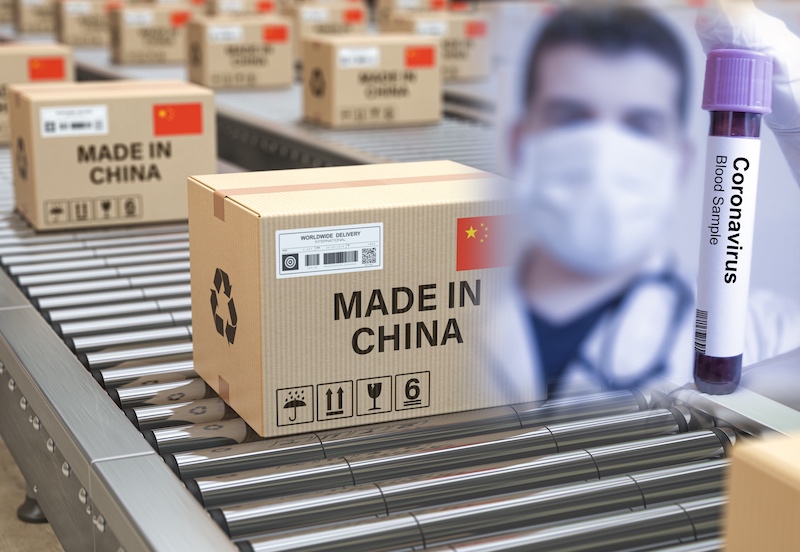
The grave risks and dangers in the process of worldwide out-sourcing and so-called globalization of the past 30 years or so are becoming starkly clear as the ongoing health emergency across China threatens vital world supply chains from China to the rest of the world.
While much attention is focused on the risks to smartphone components or auto manufacture via supplies of key parts from China or to the breakdown of oil deliveries in the last weeks, there is a danger that will soon become alarmingly clear in terms of global health care system.
If the forced shutdown of China manufacture continues for many weeks longer, the world, could begin to experience shortages or lack of vital medicines and medical supplies.
The reason is that over the past two decades much of the production of medicines and medical supplies such as surgical masks have been outsourced to China or simply made in China by Chinese companies at far cheaper prices, forcing Western companies out of business.
Sole source China
According to research and US Congressional hearings, something like 80% of present medicines consumed in the United States are produced in China. This includes Chinese companies and foreign drug companies that have outsourced their drug manufacture in joint ventures with Chinese partners.
According to Rosemary Gibson of the Hastings Center bioethics research institute, who authored a book in 2018 on the theme, the dependency is more than alarming.
Gibson cites medical newsletters giving the estimate that today some 80% of all pharmaceutical active ingredients in the USA are made in China.
“It’s not just the ingredients. It’s also the chemical precursors, the chemical building blocks used to make the active ingredients. We are dependent on China for the chemical building blocks to make a whole category of antibiotics… known as cephalosporins. They are used in the United States thousands of times every day for people with very serious infections.”
The made in China drugs today include most antibiotics, birth control pills, blood pressure medicines such as valsartan, blood thinners such as heparin, and various cancer drugs. It includes such common medicines as penicillin, ascorbic acid (Vitamin C), and aspirin.
The list also includes medications to treat HIV, Alzheimer’s disease, bipolar disorder, schizophrenia, cancer, depression, epilepsy, among others. A recent Department of Commerce study found that 97 percent of all antibiotics in the United States came from China.
Few of these drugs are labeled “made in China” as drug companies in the USA are not required to reveal their sourcing. Rosemary Gibson states that the dependency on China for medicines and other health products is so great that, “…if China shut the door tomorrow, within a couple of months, hospitals in the United States would cease to function.” That may not be so far off.
At the time the outsourcing of US and European drug manufacture to China began no one could imagine the present health catastrophe growing out of Wuhan in a matter of days.
The massive China quarantine since late January has shut some 75-80% of all Chinese factories and created an unprecedented domestic China demand for every kind of medical product since the WHO declaration of medical emergency around the coronavirus or COVID-19 events at the end of January.
It is unclear how badly deliveries of vital pharmaceuticals including essential antibiotics from China to the USA or Europe or other countries will be affected though anecdotal reports of hospitals beginning to experience delivery problems are surfacing.
Even the idea to turn to India, another major global pharmaceutical supplier, only finds that most Indian manufacturers are dependent on China for their active drug ingredients.
Clinton and Outsourcing
The emergence of China in recent years as the global giant in terms of pharmaceutical drugs and products is embedded in the Made in China-2025 national plan as one of the ten priority areas for China to gain world leadership. It has not been simply a random chance development. This in turn, as the present COVID-19 crisis makes starkly clear, is a huge vulnerability for the rest of the world.
How did such a one-sided situation develop? We have to go back to the role of the Clinton Presidency in what was then dubbed globalization, the Davos model of outsourcing any and everything from advanced industrial countries like the USA or Germany to especially China after 2000.
In May 2000 in one of the most far-reaching actions of his Presidency, Bill Clinton, with the strong backing of US multinational companies, succeeded, over the strong objections and warnings of many trade unions, to get Congressional passage of a permanent “most-favored nation” trade status for China and US support for China entry into the World Trade Organization.
That gave the green light to corporate America for a flood of overseas investment in cheaper China manufacture known as “out-sourcing.”
Major US drug makers were among them. Within two years of the passage of the US free trade agreement with China the US shut its last penicillin fermentation plant in New York State as a result of severe Chinese low-price competition.
In 2008, the Chinese government designated pharmaceutical production as a “high-value-added industry” and bolstered the industry through subsidies and export tax rebates to encourage pharmaceutical companies to export their products. By 2019 China had become by far the world’s largest source for active pharmaceutical ingredients (APIs).
The Achilles Heel of this globalization and sole dependency for vital medicines on one country now becomes alarmingly clear as the future of China as a reliable supplier of needed drugs and other medical supplies has suddenly become a matter of grave concern to the entire world.
William Engdahl is strategic risk consultant and lecturer, he holds a degree in politics from Princeton University and is a best-selling author on oil and geopolitics, exclusively for the online magazine “New Eastern Outlook.”
First published by NEO
The 21st Century
